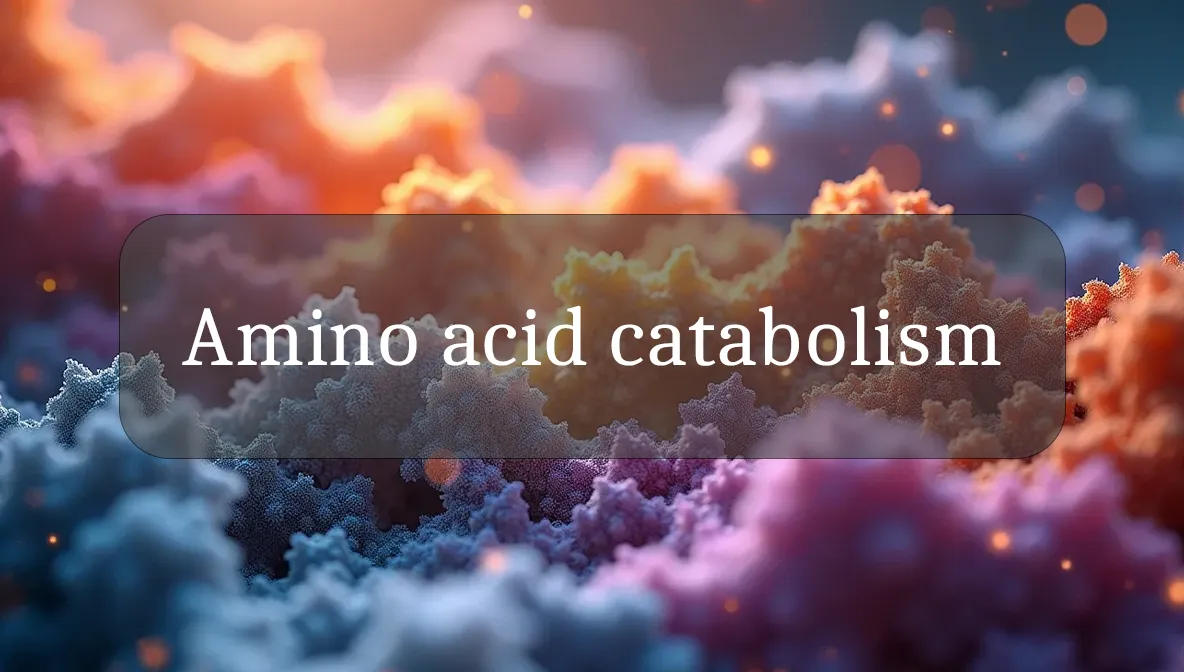Body’s Protein Recycling System
Amino acid catabolism is the process your body uses to break down amino acids, the building blocks of proteins, to produce energy, create new molecules, or eliminate excess nitrogen. This metabolic pathway is like a recycling plant, ensuring your body uses proteins efficiently to stay energized and balanced. Let’s explore what amino acid catabolism is, its role in your wellness, and how to support it for daily vitality.
Identity and Function
Amino acid catabolism is a series of biochemical reactions that degrade amino acids into smaller molecules, primarily in the liver and muscles. The process starts by removing the amino group (via transamination or deamination), producing ammonia (converted to urea for excretion) and carbon skeletons. These skeletons are then used to generate energy (via the citric acid cycle), form glucose (gluconeogenesis), or synthesize fats (lipogenesis). Key enzymes like aminotransferases and urea cycle enzymes drive this process.
Biological Role and Health Impact
Amino acid catabolism is crucial for keeping your body functioning and resilient:
- Energy Production: It provides energy when carbs or fats are low, such as during fasting, intense exercise, or starvation, keeping you active.
- Blood Sugar Regulation: Some amino acids (glucogenic) are converted to glucose, stabilizing blood sugar during fasting or low-carb diets.
- Waste Removal: It safely eliminates excess nitrogen as urea via the liver’s urea cycle, preventing toxic ammonia buildup.
- Metabolic Flexibility: Carbon skeletons can form ketones (ketogenic amino acids) or fats, supporting energy needs or storage.
- Tissue Repair: By recycling amino acids, it supports protein turnover, aiding muscle repair, immune function, and hormone production.
By breaking down amino acids efficiently, catabolism supports energy, metabolism, and detoxification, keeping you strong and healthy.
Production and Sources
Amino acid catabolism occurs naturally, driven by diet and body needs:
- How It Works: The liver processes dietary amino acids (from protein-rich foods) or those released from muscle breakdown during fasting or exercise. The kidneys and muscles also contribute to catabolism.
- Dietary Influence: Proteins (meat, eggs, beans) provide amino acids for catabolism. High-protein diets increase catabolic activity, while low-protein diets reduce it.
- Key Nutrients: B vitamins (B6 in bananas, B3 in fish) and folate (spinach, lentils) support enzymes like aminotransferases. Magnesium (nuts, seeds) aids metabolic reactions.
- No External Sources: Catabolism is an internal process; you don’t consume its products directly.
A balanced diet with adequate protein supports efficient amino acid catabolism.
Signs of Imbalance
Imbalances in amino acid catabolism can lead to metabolic or health issues:
- Impaired Catabolism:
- Fatigue, weakness, or muscle loss if amino acids aren’t converted to energy or glucose effectively.
- Ammonia buildup (hyperammonemia), causing confusion, nausea, or, in severe cases, coma (e.g., in urea cycle disorders).
- Excess Catabolism:
- Muscle wasting or weight loss from excessive protein breakdown, seen in starvation, chronic illness, or overtraining.
- High urea levels, straining kidneys or causing dehydration.
- Metabolic Disorders:
- Symptoms like developmental delays, seizures, or bad breath in rare genetic conditions (e.g., phenylketonuria or maple syrup urine disease). If you notice persistent fatigue, muscle loss, or unusual symptoms, see a doctor for tests like blood ammonia, urea, or amino acid profiles.
Supporting Healthy Function
To keep amino acid catabolism balanced and body-healthy:
- Eat Adequate Protein: Aim for 0.8–1.2g protein per kg body weight daily (e.g., chicken, tofu, lentils) to provide amino acids without overloading catabolism.
- Balance Carbs and Fats: Include complex carbs (oats, sweet potatoes) and healthy fats (avocado, nuts) to spare amino acids for repair rather than energy.
- Exercise Moderately: Strength training or cardio (30 minutes most days) promotes muscle maintenance, reducing excessive catabolism.
- Stay Hydrated: Drink 8–10 cups of water daily to support kidney function and urea excretion.
- Support Liver Health: Limit alcohol (1 drink/day for women, 2 for men) and avoid processed foods to keep your liver efficient at catabolism and detoxification.
Safety and Precautions
Amino acid catabolism is a natural process, but health conditions or lifestyle factors require care:
- Medical Conditions: Liver or kidney disease, diabetes, or genetic disorders (e.g., PKU) can disrupt catabolism, requiring medical management.
- Medications: Drugs like corticosteroids can increase protein breakdown, boosting catabolism. Use as prescribed and monitor with your doctor.
- Hormonal Factors: Stress or thyroid disorders can accelerate catabolism, leading to muscle loss. Discuss symptoms with your doctor.
- Genetic Risks: Rare metabolic disorders (e.g., urea cycle defects) impair catabolism, needing specialized care. Screen if you have a family history of metabolic issues.
- High-Protein Diets: Excessive protein (over 2g/kg/day) can strain kidneys or increase urea, especially in those with kidney issues. Consult a dietitian.
If you have fatigue, muscle issues, or metabolic concerns, consult a healthcare provider for tests like liver function or metabolic panels.
Fun Fact
Did you know your body can turn the amino acids from a steak into sugar for your brain? Through gluconeogenesis, amino acid catabolism keeps your blood sugar steady even if you skip the carbs!
Citations
- National Institutes of Health (NIH): Amino Acid Metabolism and Catabolism.
- Mayo Clinic: Protein Metabolism and Health.
- Cleveland Clinic: Understanding Liver and Kidney Function.
- American Society for Biochemistry: Amino Acid Catabolism Pathways.
- Journal of Biological Chemistry: Amino Acid Metabolism (2020).

